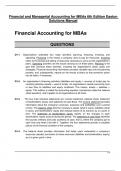Tentamen (uitwerkingen)
Solution Manual for Financial and Managerial Accounting for MBAs 6th Edition Easton / All Chapters 1 - 25 / Full Complete 2023
- Vak
- Instelling
Solution Manual for Financial and Managerial Accounting for MBAs 6th Edition Easton / All Chapters 1 - 25 / Full Complete 2023
[Meer zien]




